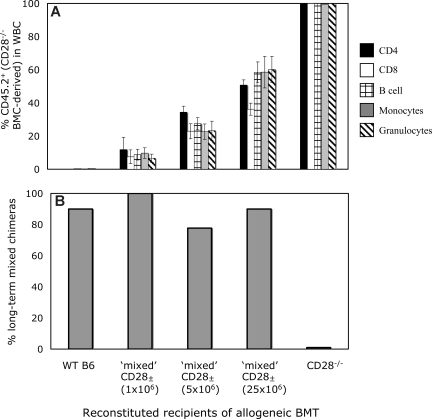Figure 6.
Lack of a T cell–intrinsic requirement for CD28 for the tolerization of CD4 T cells. (A) Peripheral levels of CD28−/−-derived WBCs in mixed CD28± mice. In B6-CD45.1 mice treated with 3 Gy TBI, the administration of increasing doses of syngeneic B6 CD28−/− (CD45.2) BMCs (1 × 106, 5 × 106, and 25 × 106) led to increasing numbers of peripheral CD45.2+ cells in the CD4, CD8, B-cell, monocyte, and granulocyte lineages. Mean levels of CD45.2+ cells in each lineage 5 weeks after syngeneic BMT are shown. (B) Mixed CD28± mice develop long-term mixed chimerism in most instances after treatment with anti-CD8, 3 Gy TBI, anti-CD154 mAb, and allogeneic BMT. WT B6 (CD45.1), B6-CD28−/− (CD45.2), and CD28± mice all received B10.A BM transplant with anti-CD8, anti-CD154, and 3 Gy TBI. Although none of the CD28−/− recipients developed chimerism (0 of 5), all remaining groups, regardless of level of CD28−./− CD4+ T cells in the periphery, developed chimerism at similar rates (9 of 10 for WT; 8 of 8 for CD28± created with 1 × 106, 7 of 9 for CD28± created with 5 × 106, and 9 of 10 for CD28± created with 25 × 106 CD28−/− BMCs). Chimerism was detected in CD4, CD8, B-cell, monocyte, and granulocyte lineages by FCM analysis for more than 25 weeks after BMT.

